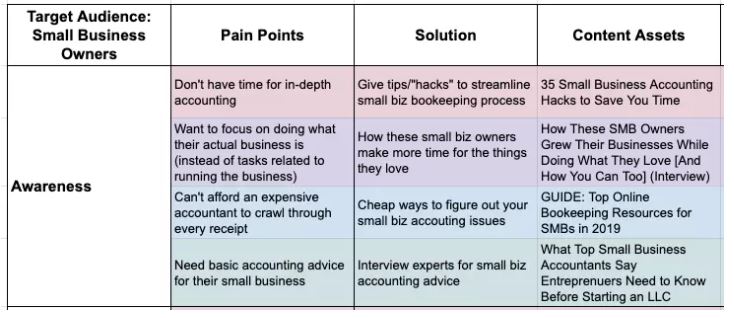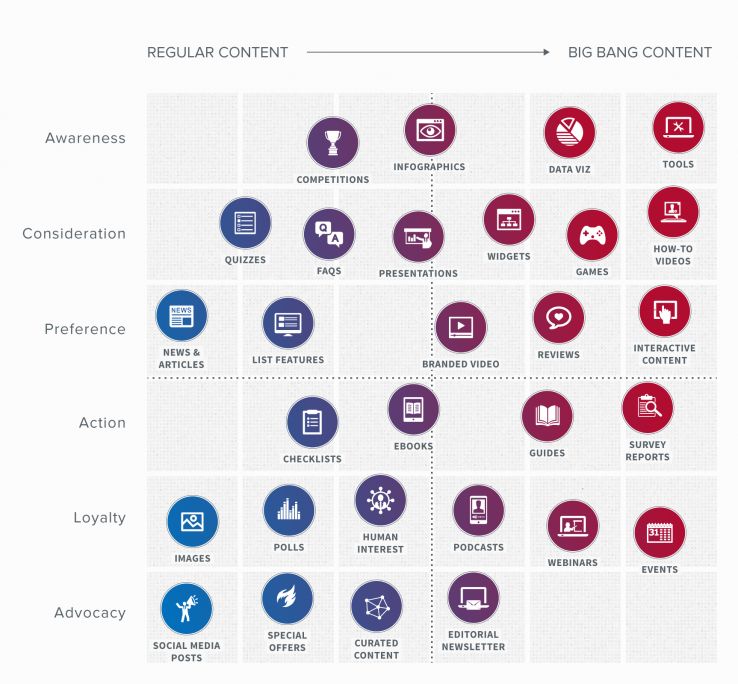A content matrix has nothing to do with Keanu Reeves, though it can be a marketer’s superpower when used correctly.
Used to map out more structured and relevant assets, this content mapping tool can help you plan and create results-focused content that lands at the right moment.
Intrigued? Keep reading to find out more about how you can add a content matrix to your marketing strategy.
What is a Content Matrix?
A content matrix is part of your content strategy, but it isn’t quite the same thing as your plan or calendar. While the latter are based on timelines and scheduling, a matrix is the ideation machine that helps organize your content and puts your target audience first.
The user-focused approach acknowledges the natural journey that your digital visitors take when researching a product or service. Rather than creating rinse-and-repeat content that answers a question and immediately tells a user to make a purchase, a matrix will help you map out the right types of content for each stage of the user journey.
From awareness to conversion and every step in between, content matrices are designed to align the conversion process with specific tactics, such as an emotional versus rational approach.
With the right mix of content, you’ll ease your viewers into buying decisions rather than trying to get them there more quickly than they would like. Plus, it will help you find the sweet spot where you’re meeting your audience’s needs along with your own sales and marketing goals.
A content matrix can take the methodical form of a spreadsheet or the visual form of a designed scatter plot. Here are some examples:

Spreadsheet example from Search Engine Journal

Scatter plot example from Moz
No matter how it looks, a matrix is a powerful framework for continuously reaching your target audience with the right content, in the right place and at the right time.
How Can Your Brand Use a Content Matrix?
It can take time to build a content marketing matrix, but the rewards will be worth it. Your brand can use this tool in various ways, including:
- Visualizing your content strategy.
- Auditing and assessing your current library of content.
- Highlighting gaps in your content marketing strategy.
- Measuring audience interest in various content types.
- Brainstorming content ideas that better connect with your target audience.
- Creating purpose- and results-driven content.
- Addressing customer pain points at the right time during the buying journey.
- Identifying areas to repurpose existing assets.
- Optimizing your resources with the most effective content creation.
- Planning for long-term results.
As a one-stop shop for highlighting strengths, pinpointing weaknesses and future-proofing your efforts, your content matrix will give your internal process an upgrade. And from the outside looking in, your audience will resonate more with your content, making them much more likely to become customers.
Subscribe to
The Content Marketer
Get weekly insights, advice and opinions about all things digital marketing.
Thanks for subscribing! Keep an eye out for a Welcome email from us shortly. If you don’t see it come through, check your spam folder and mark the email as “not spam.”
How Do You Create a Content Matrix? (+ Infographic & Template)
Here are the basic steps you can follow to create a content matrix — though it’s worth noting that customizing a content matrix to your target audience and business goals will lead to a framework that’s uniquely yours. No need to worry if it doesn’t look like the examples shared above or if your process takes a slightly different direction!

1. Define Your Target Audience(s)
Odds are you already know your target audience pretty well, but considering your matrix is about reaching users with more targeted and timely content, you’ll want to ground yourself in your buyer personas.
What kind of people does your brand talk to? What are their hopes, dreams and fears? Where do they live, work and play? What are their pain points and how does your product or service solve them?
The more granular you get, the more targeted your content will be to your audience. With this in mind, you may even want to subdivide your target audience into different categories so you can create more curated content.
2. Choose Content That Follows Your Customer Journey
Consider the path your customers generally take to making a buying decision. From a high-level perspective, they likely go from awareness to consideration to decision-making.
Now think about what influences your audience at each stage and how you best address their pain points based on their mindset. This will help you match content types and ideas with the corresponding stage.
And when we say “content type” we mean truly any kind of asset — blogs, emails, infographics, eBooks, videos, case studies, landing pages, podcasts and so on. The important thing is that they align with your marketing goals and lead to thoughtful calls to action that keep users moving to the next stage.
Pro-tip: Don’t forget to delight your audience after they make a purchase! Even a simple thank-you email goes a long way to encourage them to buy again or refer others to your brand.
3. Turn Your Insights Into a Content Matrix
Once you nail down the details about your target audience, customer journey and content assets, you can map it all out in the form of a content matrix.
A good place to start could be an audit of all the content you already have and mapping each asset along the customer journey. Once you have that visual, you can add in your new ideas.
Your content matrix can be as detailed as you’d like. For example, a spreadsheet matrix may have columns that describe your audience pain points, your solutions to the pain points, content assets and CTAs.
Others are more simplified, listing out generic content that falls under each stage. For example, awareness content is emotional and entertaining — examples include short videos, social posts, blog articles, games and quizzes.
Basically, the content matrix choices are yours to make!
How Do You Stick to Your Content Matrix Over Time?
As with anything in marketing, your content matrix should have the flexibility to adapt to changes in your audience needs, wants and trends. Plus, you’ll want to add new assets to your matrix once they’re ready for distribution.
Ultimately, using a content matrix over time means creating a living and breathing marketing tool that you update when necessary.
Here are some content matrix best practices to keep in mind as you make it part of your ongoing strategy:
- Make your content matrix a central home for all content types. No need to have separate ones for blogs, social posts, white papers and so on!
- Don’t try to skip from one end of your matrix to the other. Instead, use thoughtful CTAs that direct users to the next piece of content that matches where they are in their journey.
- Use backlinks! This will ensure your existing content is still pulling its weight.
Once your content matrix exists, be sure to start using it in the wild. It’s a great visual aid for meetings as well as grounding your marketing team in a results-driven approach. The more you use your content matrix and incorporate it in everything from planning to execution, the more you’ll get out of it.
Download Your Free Content Matrix Template
No need to start from scratch! Download this free template to jump right in.
Drive Results With a Content Matrix
With a content matrix to guide your strategy, planning, creation and distribution, you’ll nurture leads through the buyer’s journey in more effective and engaging ways. Before you know it, you’ll be reaching your desired results and scheduling a happy hour to celebrate the results with your team.



